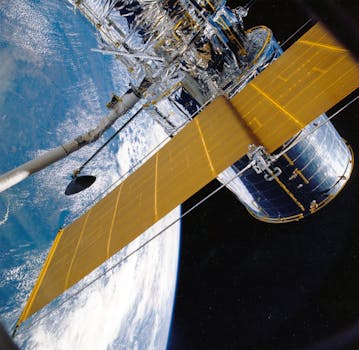The Future of Satellites: Revolutionizing Global Communication and Exploration

The Future of Satellites: Revolutionizing Global Communication and Exploration. The future of satellites holds great promise for revolutionizing global communication, exploration, and development. With advancements in technology, satellites are becoming more efficient, cost-effective, and versatile. Satellites have been a crucial part of modern life, providing services such as navigation, communication, weather forecasting, and remote sensing. However, the future of satellites is expected to be even more exciting, with new technologies and innovations emerging every day.
One of the most significant advancements in satellite technology is the development of small satellites, also known as CubeSats. These satellites are smaller, lighter, and less expensive than traditional satellites, making them more accessible to a wider range of users. Small satellites are being used for a variety of applications, including Earth observation, communication, and scientific research. They are also being used to provide internet connectivity to remote and underserved areas, helping to bridge the digital divide.
Advancements in Satellite Technology
Another area of advancement in satellite technology is the development of reusable launch vehicles. Companies such as SpaceX and Blue Origin are working on reusable launch vehicles that can significantly reduce the cost of launching satellites into space. This technology has the potential to make space travel more affordable and accessible, enabling more satellites to be launched into space. Additionally, advancements in propulsion systems, such as electric propulsion and advanced ion engines, are being developed to increase the efficiency and lifespan of satellites.
Satellite constellations are another area of development, with companies such as OneWeb and Amazon’s Kuiper Systems planning to launch thousands of satellites into low Earth orbit. These constellations will provide global internet coverage, enabling remote and underserved areas to access high-speed internet. They will also provide a range of other services, including navigation, communication, and Earth observation.
Applications of Satellites
Satellites have a wide range of applications, from communication and navigation to weather forecasting and remote sensing. They are used in various fields, including agriculture, disaster response, and environmental monitoring. Satellites are also being used to study the Earth’s climate, oceans, and land surfaces, providing valuable insights into the health of our planet.
In addition to these applications, satellites are also being used for scientific research, such as studying the universe, black holes, and dark matter. They are also being used to test new technologies, such as quantum communication and gravitational wave detection. The use of satellites in space exploration is also becoming more prominent, with satellites being used to study other planets and celestial bodies.
Challenges and Opportunities
Despite the many advancements and applications of satellites, there are also challenges and opportunities that need to be addressed. One of the biggest challenges is the increasing amount of space debris in Earth’s orbit, which poses a risk to operational satellites and other space-based assets. There is also a need for more sustainable and environmentally friendly satellite technologies, as well as more effective ways to manage and regulate the use of space.
However, these challenges also present opportunities for innovation and growth. The development of new technologies and services, such as satellite-based internet and Earth observation, is creating new opportunities for businesses and entrepreneurs. The use of satellites in space exploration is also opening up new avenues for scientific discovery and exploration.
Conclusion
In conclusion, the future of satellites is exciting and full of promise. With advancements in technology, satellites are becoming more efficient, cost-effective, and versatile. They are being used in a wide range of applications, from communication and navigation to weather forecasting and remote sensing. However, there are also challenges and opportunities that need to be addressed, such as the increasing amount of space debris and the need for more sustainable and environmentally friendly satellite technologies.
As the use of satellites continues to grow and evolve, it is likely that we will see even more innovative and exciting developments in the future. Whether it is the development of new technologies, the launch of new satellite constellations, or the exploration of new celestial bodies, the future of satellites is sure to be an exciting and rapidly changing field.





